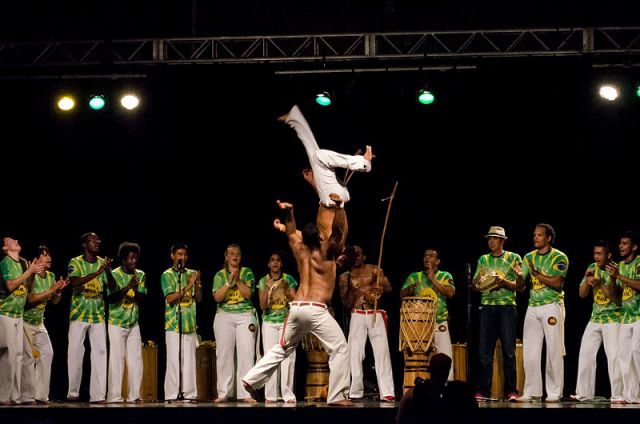Capoeira, a creation of Afro-Brazilian slaves in the 16th century, is now a recognized sport and form of martial arts.
Jogar capoeira, literally play capoeira, involves using acrobatismo, acrobatics, dança, dance and música, music in an incredible display of physical dexterity and ritualistic performance to participate in a competition.
Capoeira was originally created to disguise real fights between two male slaves. Since any fighting among slaves was harshly punished, they started incorporating rituals, music and dance into their fights to pretend they were playing a game.
When slavery was abolished in Brazil in 1888, capoeira continued to be practiced and its movements become increasingly organized, especially in Bahia. For a period, it was in fact practiced in violent combats in which challengers even employed knives or razors held with their toes. As a result, Capoeira was outlawed for many years in the beginning of the twentieth century and transgressors were sent to prison. In spite of the prohibition, it continued to be performed in hiding, developing into a form of sport for many who admired the ritmos, rhythms, habilidades, skills and movimentos, movements it incorporates into its practice.
By 1920, some forms of capoeira were back in the streets of Bahia as a form of atração turística, tourist attraction. In 1932, Mestre Bimba, a master practitioner, managed to take capoeira out of the streets by opening the first capoeira academy in Salvador, Bahia.
The movements performed by past fighters are the same used in Brazil and in many other countries where it is practiced today. It is not uncommon to see a roda de capoeira, capoeira circle, with its adjacent group of musicians and singers performing in parks and streets in many big cities all over the world.
As a martial art it is regulated and features a structure with master fighters and several levels of jogadores, players that undergo batismos, baptisms, or ritual competitions, to achieve a higher stage within the practice. Using as many as 60 different offensive and defensive movements, such as chute, kick, ginga, footwork, bananeira, handstand and cambalhota, cartwheel, capoeira is a fantastic way to increase physical fitness, balance and grace. It is also a very lively way to improve Portuguese and learn about Brazilian culture. Give it a try!
Watch a short video of this great Brazilian export:
